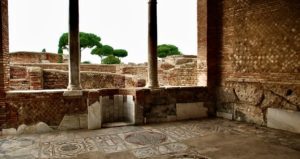
The endlessly interesting ancient city of Ostia was founded, tradition insists, by Ancus Martius, fourth king of Rome (640-616 B.C.), at the point where the Tiber ceaselessly pours itself into the Tyrrhenian, about 15 miles southwest of the capital. But modern excavations have yielded no traces of anything earlier than the fourth pre-Christian century. (The name Ostia derives from the Latin word ostium, meaning the mouth of a river).
What is certain is that Ostia served originally as a naval base, more particularly as a lookout post for trouble, i.e. invaders coming from the sea. Situated on alluvial soil on the left bank of the river, the castrum (camp) was fortified by lofty walls pierced by four gates.
______________________________
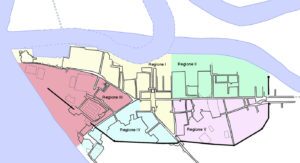
Map of Ostia Antica, as represented by its various regione. MM, Creative Commons Attribution-Share Alike 3.0 Unported, Wikimedia Commons
______________________________
From Base to Port City
By the late Republic, Rome’s growing population of more than a half-million had an ever increasing need for imported grain. This was due to the fact that many once prosperous farms in the surrounding countryside had been abandoned, their struggling owners having moved – bag and baggage – into Rome to place themselves on the welfare rolls. Wheat in huge quantities came in from Africa, Egypt, and Sicily. (Ostia was about two days’ sailing distance from North Africa). Wine and olive oil arrived from Spain, produce from the Naples region. From Babylonia came clothing, from Cappadocia in Asia Minor panels of colored marble, from India and Arabia a wide range of goods. This cornucopia of merchandise was transferred to barges at the port and then towed by oxen upstream to Rome. (A towpath on the right bank of the Tiber led all the way to the fabled city.)
All this activity meant jobs and business opportunities. Shipping firms proliferated. The shipbuilding and ship repair industries flourished. Stevedores (dock laborers) were needed by the thousands to load and unload at the docks. Warehouses sprung up seemingly beyond number. These also required laborers, watchmen, and clerks. Ropemaking and carpentry kept thousands more occupied. To satisfy the hunger and thirst and need for lodgings of foreign seamen in port at any given time, inns and cheap restaurants and bars abounded.
_______________________________

Insula in Ostia Antica. Charles Gardner, Public domain, Wikimedia Commons
_______________________________
Thanks to modern excavation techniques, 38 of these popinae (taverns) have come to light. An example of one of these raucous hangouts can be found on the Via di Diana, featuring two large rooms, one with a long counter, or bar, with an oven at the base for keeping the food hot. These are quite well illustrated in a fresco on a side wall showing a plate of peas, and a glass that seems to contain olives in saltwater.
In the wee hours of the morning, besotted foreign sailors would stumble out of these watering holes, often raising a ruckus. Swear words and bawdy songs in an array of languages echoed in the alley ways. Nearby residents would complain about the difficulty in getting a decent night’s sleep.
______________________________

Via di Diana, Ostia. Massimop, Creative Commons Attribution-Share Alike 3.0 Unported license, Wikimedia Commons
______________________________
Ostia also hosted many brick-making factories. Since the Romans built their four-story tenements (called insulae) out of brick, this was a critical and thriving industry. The few large brickworks and the numerous smaller ones used slave labor. A slave-worker could turn out more than 200 bricks a day.
______________________________
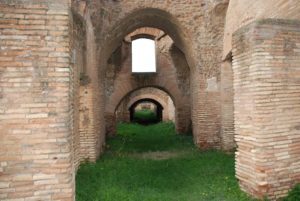
The use of brickwork was massive in Ostia. Camelia.boban, Creative Commons Attribution-Share Alike 3.0 Unported, Wikimedia Commons
______________________________
Inevitably, this fever of activity spawned yet another bloated bureaucracy. The government set up the Annona, an agency to supervise the shipping and distribution of foodstuffs and other goods, to examine and control its quantity and quality, to conduct shipside inspections, and to attend to payment of fees and tariffs. To ensure the government’s interests and the public safety in this congested, turbulent, and traffic-plagued city, a detachment of Rome’s finest soldiers patrolled the streets and piers day and night.
During the early Empire, the maritime city underwent extensive urban renewal. The biographer Suetonius (A.D. 69-122) had this to say on the subject:
“The Emperor Claudius constructed the new harbor at Ostia by building curved breakwaters on the right and left, while before the entrance he placed a mole of deep water. To give this mole a firmer foundation he first sank the ship in which the great obelisk had been brought from Egypt, and then securing it by pilings, built upon it a very lofty tower modeled on the Pharos at Alexandria, to be lighted at night to guide the course of ships.”
Claudius spent a great deal of time on the scene personally overseeing his ambitious project. This innovative deep water harbor, with the lighthouse, transformed Rome’s access to trade from all over the Mediterranean. (One curious note: The obelisk Suetonius mentions was brought to Rome from Heliopolis by order of Caligula. It once stood on the dividing island of his racetrack in the Vatican meadows. Since 1586, thanks to Pope Sixtus V, it has served as the monumental centerpiece of St. Peter’s Square. Some writer once called it the world’s most exquisite exclamation point.)
The Emperor Trajan (A. D. 98-117, that great city planner, and his successor Hadrian (A.D. 117-138) also committed massive sums of government funds to further develop and modernize the port city, giving it a distinctive urban character. There were now regularly laid out streets, in a typical Roman grid, with paved sidewalks; state-of-the-art baths; an impressive courthouse (basilica); up-to-date massive warehouses (horrea); modernized apartment complexes four stories high with central courtyards, interior staircases, and balustraded balconies. These living quarters of the common people sometimes arose side-by-side with the posh villas of the rich, with their atria and peristyles and colonnades.
There were also now numerous fire stations and barracks to house the cohorts of firemen in order to combat the frequent fires which were often destroying warehouses and the vital food supplies stored in them. There were rows of shops along the Decumanus Maximus (Latin for the principal thoroughfare or central main street). Often on the sidewalk in front of these retail shops were fine black and white mosaics depicting the services or wares offered inside. These mosaics accommodated the illiterates among the locals as well as the hordes of foreign seamen who could not read Latin. (In the remains of the Baths of Neptune there is a large masterpiece of this jigsaw-puzzle art form showing the Sea god in his chariot driving a team of horses along the water’s floor.)
Outdoor meat and produce markets drew crowds daily. The fishmongers set up their stalls down near the harbor. Thermopolia (fast food stands) were to be found all over town. So too were public latrines with continuously running, constantly flushing water for better hygiene. (These mundane facilities did have some aesthetic touches though: rows of marble seats, paintings, statuary, and such. Privacy and modesty, however, were out of the question. Even the upper class at times had to resort to these “restrooms”. Friends would run into one another there, sit next to each other, converse casually, and even exchange dinner invitations, without embarrassment.)
_____________________________

This shop, a thermopolium, in a prime position near the Forum, sold hot food and drink. In the centre is the bar counter, with shelves and basins for washing dishes. To the right there is a kitchen with large storage jar and a built-in stove. To the rear, there was a small courtyard with a fountain and benches where customers could sit outside in fine weather. Dennis Jarvis, Creative Commons Attribution-Share Alike 2.0 Generic license, Wikimedia Commons
_____________________________

Signage associated with thermopolium. Massimop, Creative Commons Attribution-Share Alike 3.0 Unported license, Wikimedia Commons
_____________________________

Public latrines in Ostia. Fubar Obfusco, Public Domain, Wikimedia Commons
_____________________________
Ostia’s 4,000-seat theater featured the works of Greek and Roman playwrights. This performing arts center is credited by many classical scholars to Marcus Agrippa (63-12 B.C.), Caesar Augustus’ friend, son-in-law, prime minister, and man-for-all-seasons. Behind the theater sprawled a vast colonnaded plaza where the import and export corporations had their offices. As a result of Ostia’s robust commercial life, numerous guilds were established with impressive buildings for their headquarters. Municipal affairs were conducted in the stately edifices of the Forum.
_____________________________
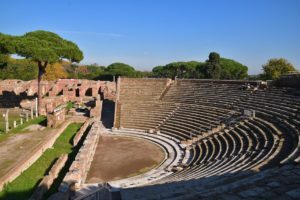
The theater in Ostia. Rabax63, Creative Commons Attribution-Share Alike 4.0 International license, Wikimedia Commons
_____________________________
Just off the Decumanus was a side street named “House of Paintings,” because of a palatial structure there known for its elaborately frescoed walls. The building’s four entrances give some researchers the idea that this might have been a hotel. On the ground floor is a fine apartment of several rooms which they surmise served as the living quarters of the hotel owner or manager.
The sophisticated and cosmopolitan nature of Ostia, with a teeming population of nearly 100,000, is further apparent from the great variety of native and foreign gods once worshiped here. In addition to the architecturally elegant shrines honoring Jupiter, Juno, Mars, Minerva, Venus, and those consecrated to the cults of deified emperors like Augustus, Vespasian, Titus, Marcus Aurelius, et. al, through archaeological and epigraphic evidence we also learn that there once existed sanctuaries to the Egyptian divinities Isis and Serapis, and to the Syrian gods Dolichenus and Maiumas. Sixteen oratories to the little Persian god of light, Mithras, survive in fragments. Mithraism was a cult that found great favor among the Roman military.
The remains of a stately synagogue were brought to light in the 1960’s, indicating the presence of a sizable Jewish community in the port city. The scattered remains include reliefs of menorahs, parts of a pulpit from which the rabbi would have read passages from the Torah, and fragments of an ark that housed the sacred scrolls. This first century A.D. site, with numerous Corinthian columns, is thought to be the most ancient Jewish house of worship in Europe.
The Christians of Ostia did not leave behind any remains of churches for Christianity. Having been outlawed since Nero’s reign (A.D. 54-68) they had to celebrate their sacred mysteries secretly in their private homes. Only after Constantine’s Edict of Milan in A.D. 313 were they permitted to erect their beautiful Romanesque shrines.
On the outskirts of the city, i.e, beyond the walls, are the cemeteries, lining the ancient roads like the Via Ostiense and the Via Laurentina. Some of the burial arrangements are elaborate – rich ornamentation and large mausolea – but others modest, little more than tombstones. Thousands of Latin inscriptions and epitaphs, still very legible, give us the names and careers of generations of Ostians from all walks of life.
There is also a type of family tomb called a columbarium, excellent specimens of which survive at Ostia. This was usually built by a man of means for himself, his wife, and their descendants, and in due course for the freedmen and freedwomen (i.e. liberated slaves) of the household, with their descendants as well. These tombs were so called because of the dozens of niches or columbaria that held the urns of ashes of the deceased. Each niche resembled a dove’s nest. (The Latin word for dove is columba.) On the front wall of a columbarium, therefore quite conspicuous, was often an engraved warning imposing a curse and heavy penalties on anyone who should “entomb herein the remains of a person with a name other than that which is contained in this message.” (From the work: Les Inscriptions du port d’Ostie by H. Thylander).
On an island in the Tiber, the Isola Sacra, are the burial grounds of the prosperous freedmen who made up the majority of the maritime trade class. (The little isle has been meticulously excavated, like much of Ostia iself, by the widely acclaimed archaeologist Guido Calza).
To all these necropoli there is an irenic and poignant and haunting beauty.
_______________________________

Via Delle Tombe, Ostia Antica – Site of numerous urns in the ancient city. ZeWrestler, Creative Commons Attribution-Share Alike 3.0 Unported license, Wikimedia Commons
_______________________________
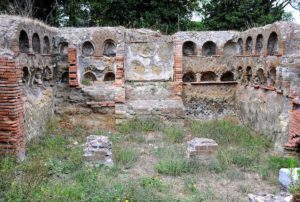
The Porta Romana necropolis (is a large cemetery or burial ground) consists of some sixty tombs. Burial places are always situated outside Roman cities. They flank roads leading to the city gates, over a long distance. The oldest burials are a group of approximately 35 cremations, that have been dated to the second and first century BC. This is a columbarium with niches for urns. Dennis Jarvis, Creative Commons Attribution-Share Alike 2.0 Generic license, Wikimedia Commons.
_______________________________
Ostia’s End
In the late fourth century, Ostia’s decline paralleled that of Rome. Then in A.D. 409, Alaric dealt a fatal blow. To bring the imperial capital into submission, he and his Goths seized the port with all its granaries on which Rome’s populace depended.
Soon afterward, the river changed course, the harbor silted up, trade ceased, and the residents began a slow but inexorable exodus. Ostia was in time abandoned and became a ghost town. As the decades and centuries passed, its buildings slowly but steadily crumbled. By the late Middle Ages sand had blown over the ruins and buried this once vibrant city on the Tyrrhenian coast. And thus this Roman colony settled into a centuries-long, eerily silent slumber.
Serious excavations were undertaken in the first part of the 1800’s by direction of Pope Pius VII (1800-1823). And then again under Pius IX (1846-1878). But these efforts, though valiant, met with only modest success. More systematic excavations were launched in 1909 and have been continued until the present day, with its high-tech advantages.
Now having been awakened from its millennium-and-a-half slumber beneath its blanket of sand – thanks to the hard, patient and skilled work of generations of dedicated archeologists – it now welcomes multitudes of classicists and history buffs and camera-toting tourists year-in and year-out. While the voices of its ancient citizens have long ago been stilled, this eternally fascinating seaside city’s bricks and stones ‘talk’ to us, vividly and eloquently relating what Roman daily life was like in that far off golden age.
Cover Image, Top Left: View of Ostia Antica, Camelia.boban, Creative Commons Attribution-Share Alike 3.0 Unported, Wikimedia Commons




